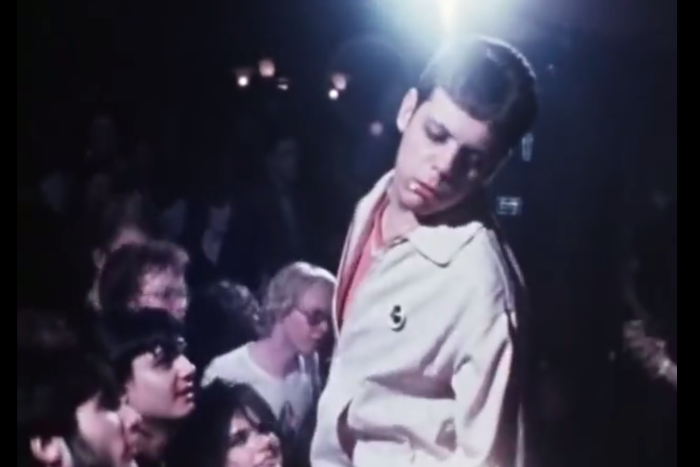Television, as a guilty pleasure, has changed for folks like you and me. You know, the kind of people who, when not going to the theatre or art galleries, read and write long-form essays on highbrow cultural websites. We’re not dummies, is what I’m saying—we are lofty, damn it. We like our mellow brew of shade-grown fair-trade leisure activities to be sweetened only slightly with the intellectual empty calories of a Storage Wars here, a Dancing With the Has-beens there.
It used to be that all TV was basically a guilty pleasure—lowbrow—the covert enjoyment of which we might have confessed to after one too many chards back in the ‘90s (“I used to be able to recite entire episodes of Family Ties!”), only to assure one another we haven’t owned a TV for years, wouldn’t dream of flushing our precious off-hours down the ever-swirling toilet of prime time. And it wasn’t just cultural stuffed-shirts like us who wouldn’t be caught dead touting television: anyone purporting to be serious-minded looked down on the pratfalls of Gilligan, the debased French farce of Three’s Company, as a matter of course. “They call it the idiot box, and it’s well named,” I remember my grandmother saying, shutting me down in the midst of what I had thought was an utterly engaging re-enactment of the previous night’s Bionic Woman. For years, television was the thing parents snapped off and nudged their children out from in front of—the thing grown-ups doled out to themselves in strict increments, like diabetics negotiating their starches. Too much of that easily broken-down sweet stuff and, next thing you know, your brain will be swimming in sugar.
Today, however, in these possibly waning days of TV’s first widely acknowledged “golden age” since the era of Norman Lear, bragging you don’t watch television is a faux pas tantamount to declaring Mel Gibson the definitive Hamlet. But as much as TV has changed for the better this past decade, with its epic anti-heroes (Walt, Tony) and ground-breakingly complex female leads (Nurse Jackie, Piper Chapman), so have our reasons to feel uneasy about it. Our intelligence is being nourished, finally, by the idiot box, but so is something else: a kind of parasite, perhaps, that bolts itself, barnacle-like, to the gloomiest corners of our collective psyche. As an avid, and usually unabashed, consumer of TV, it’s not the sweet stuff that pricks my conscience anymore, but the flavour that’s replaced it—the bitter, the sour, the downright vile. Call it the New Darkness. I am guilty because I cannot get enough.
When your life has been scarred by the murder of a loved one, she explained, our culture’s blithe overindulgence in “murder as entertainment” can feel like a punch in the gut. As an example, she referenced the phenomenon of “murder mystery” dinner theatre. Why, she wanted to know, did we not hold “rape mystery” dinners, where someone is play-raped by an anonymous criminal, and everyone has to figure out whodunit? Obviously, the very idea is sickening. So why is play-murder considered all in good fun?
When searching for viewers like myself, Dexter tends to be an effective litmus test. During its eight-season run, people resolutely did or did not watch Dexter—it was not the kind of show one felt indifferently about. Either you were willing to root for a bloodthirsty sociopath who nonetheless only killed “bad guys” or you were not. And if you asked an acquaintance if they watched the show, one of two things would happen: a face would either open up, or it would shut completely down.
If you talk to those in the TV industry today, the same thing occurs. These are business-minded people, understand, well aware that Dexter was not just a hit, but a bona fide sensation—and still, their faces will either open or close. The most cynical producer might think nothing of green-lighting a reality show called, say, Downward Spiral, documenting a strung-out former child star’s final romance with the glass pipe, yet will frown at the mention of Dexter as a wall of ice comes down between you. Many people who work in television are fans first, and the fan in them—the wide-eyed kid who grew up re-enacting episodes of the original Battlestar Galactica with their Barbies and GI Joes—simply can and will not stomach the sheer moral ambivalence and out-and-out pleasure-taking in violence that Dexter represents. Dexter is not TV as they were raised to understand and love it.
But there is another kind of fan out there. For some of us—the weirdos sitting in the dark these past few decades, cackling along with the gory punsters of Tales from the Crypt, obsessing over the more grotesque and outlandish X-Files cases with Agent Mulder—Dexter represents exactly the kind of thing we understand and love. When we find each other, our faces open up. We talk about Dexter. We talk about the trailing entrails of The Walking Dead. The Red Wedding. The mangled and dangling prostitutes of True Detective. Not to mention the network gorefest of the moment, Hannibal, to which we’ll return shortly. But more and more, the current TV landscape, network and cable alike, seems to be contorting to our twisted specifications.
One showrunner whose face closed up entirely at the mention of Dexter told me he felt morally compromised by the series. I understand this—the assertion of the face-closers that Dexter is, essentially, bad. But in the words of Martin Amis, why is it so bad? And when I say bad, I’m not talking about the excruciating unwatchability of its final season, or all the other times Dexter muffed it just in terms of basic storytelling.11But this is part of my point—I can’t even make the argument that Dexter was superlative TV. It was often good, but it wasn’t that good. I’m talking about the morality of violence—excessive violence—as entertainment, and of psychopathic sadist as hero. This may be an old argument; viewers who delight in violent television (and if it’s not yet clear, I’m one) typically roll their eyes at such discussions. Morality? It’s TV! Realm of “Bazinga!” and home of Honey Boo Boo. The whole point is not to take it seriously. But this is where my friends and I part company.
I once heard the memoirist Rachel Howard, whose father was murdered when she was 10, being interviewed about the trauma that family members of murder victims must confront every time they turn on their TVs. When your life has been scarred by the murder of a loved one, she explained, our culture’s blithe overindulgence in “murder as entertainment” can feel like a punch in the gut. As an example, she referenced the phenomenon of “murder mystery” dinner theatre. Why, she wanted to know, did we not hold “rape mystery” dinners, where someone is play-raped by an anonymous criminal, and everyone has to figure out whodunit? Obviously, the very idea is sickening. So why is play-murder considered all in good fun? Of course, television does host more than its share of murder- and rape-mystery nights in the form of Law and Order: SVU (to say nothing of the latest Game of Thrones controversy). Maybe there’s no horror that television can’t package for our amusement.
Wallowing is the ground that Dexter broke, taking and imparting an unabashed sensual delight in murder—murder lovingly lit and splendidly shot. Now his even creepier little brother Hannibal arrives on the scene, an aesthete to Dexter’s journeyman. Whereas lab-geek Dexter brought a scientist’s cold precision and rationality to his work, Hannibal’s is so much more horrific for being the playful yet obsessive precision of an artist. Hannibal kills with flair.
Why are we so endlessly amuseable in this way? There seem to be two separate pleasure-centers being stimulated by such programming. The first—most common and most forgivable, perhaps—is the basic human appetite for drama. Human suffering is, after all, the nut of all drama, and death, and the threat thereof, its apex. Televised storytelling—in North America, anyway—is about neither nuance nor subtlety; there’s a reason our programming doesn’t dally with, say, the quiet emotional devastations of an EM Forster drawing room. The escapist element requires that TV drama feel excessive, over the top, because that way we won’t relate to it too closely. Yes, death is something we all experience in real life, but not every day, in excess. The drama of daily life is much more Forsterian—the aching mundanity of heartbreak, disappointment, and insult. And who wants to sit down in front of more of what life is actually like at the end of a long day? (Those words could be the epitaph of HBO’s Enlightened—the brilliant, now-cancelled Laura Dern vehicle that cut just a little too close to the real-life brutalities cited above.) So let’s forgive ourselves our appetite for drama. When people die in real life it’s a tragedy. When people die in fiction, it’s a story—often a good one. This doesn’t make us monsters.
But it’s the other appetite, the other pleasure-center throwing sparks, that gives me trouble. And just how receptive that section of your psyche happens to be toward the red-smeared caresses of horror television is what separates the weirdos in the basement from the rest of us—or, should I say, the rest of you. And so at last we arrive at—no, not Reginald LeDoux, although the tattooed villains of True Detective are certainly within our purview here. No, right now I’m after bigger game—the gory gourmand himself. Hannibal.
Why should NBC’s Hannibal rate more attention than HBO’s equally dark but visually gorgeous, brilliantly written (by a novelist, Nic Pizzolatto, no less), and flawlessly acted True Detective? Precisely because Hannibal, unlike True Detective, has no pretensions to being “prestige TV,” meaning high-minded viewers can’t excuse themselves for enjoying the former as easily as they might the latter. Admittedly, when I realized the female lead of True Detective was yet again a corpse (in the endless tradition of Laura Palmer and Rosie Larsen), I rolled my eyes and thought, Okay—this better be good. And yes, it was better than good. But we’re not here to talk about excellence. Excellent series such as Breaking Bad and The Sopranos certainly earned their places in the pantheon by indulging in, and pioneering to some extent, the New Darkness (picture Gus Fring straightening his tie with half his face blown off, or Adriana dragged screaming from the back of Sal’s car), but they did so judiciously—occasionally dipping a toe into the bloodbath, but never explicitly wallowing in it. Wallowing is the ground that Dexter broke, taking and imparting an unabashed sensual delight in murder—murder lovingly lit and splendidly shot. Now his even creepier little brother Hannibal arrives on the scene, an aesthete to Dexter’s journeyman. Whereas lab-geek Dexter brought a scientist’s cold precision and rationality to his work, Hannibal’s is so much more horrific for being the playful yet obsessive precision of an artist. Hannibal kills with flair.
The show’s level of obscenity is, I think, directly proportional to the amount of fun its creators seem to be having in constructing its fiendish set pieces. “This is performance,” says good-guy Will Graham in an early episode, referring to an artful tableau left by the killer (a dead naked lady, natch, mounted atop a severed stag’s head) for the FBI to find in a meadow. “Field kabuki,” Will calls it. Thus has series creator Bryan Fuller established the show’s moral parameters: not reality, but hyperreality. So have as much fun with it as you want, he seems to be saying to his writers, set designers, and fans alike.
And brother, these people are having a blast. Fans call themselves “fannibals” and live-tweet episodes on Twitter, incorporating cutesy hashtags such as #inDIEgestion (because he’s a cannibal! Get it?). The Twitter avatar of one of its stars, Aaron Abrams, displays a still of the actor bending over a dead man whose throat has been cut and whose tongue has been yanked down to protrude through the bloody slit, i.e. an “Italian necktie”—a murderous leitmotif of one particular episode. And then there are the actual episodes. One (spoiler alert) features a man whose leg Hannibal has wantonly amputated being miserably wheeled up to an elaborate dinner table and served a delicious-looking portion of meat that turns out to be, yes, a section of his own missing limb. Which he then eats.
The ludicrousness of many of these murders is underscored by their sheer physical impossibility: a corpse who has been grafted onto a blossoming cherry tree with flowers blooming where his organs used to be is somehow installed overnight in a parking lot. A massive, grotesquely gorgeous totem pole of human body parts is erected overnight on a public beach. This quality of unlikelihood is not troubled over: “impossible” is the all-excusing word you’re meant to cling to, psychologically. Over the top. Field Kabuki. You’re not taking delight in the evisceration of your fellow beings—you’re watching something essentially silly.
The show features many cozily sinister depictions of Hannibal at work in his gleaming kitchen. Played by the Danish actor Mads Mikkelsen (whose muted, blank-slate performance makes Anthony Hopkins’ Dr. Lecter look like Dr. Evil), Hannibal fingers recipe cards written in flawlessly beautiful script, doubtless his own, perusing preparations for tongue, lung, heart, and kidneys. He heaves a pair of freshly harvested lungs onto his cutting board, kneads them to remove any air before slicing and dicing. When we return after a brief commercial break, he’s serving up a meal of sweetbreads to his ooh-ing guests, the artful plating of which alone would send the judges of Top Chef into ecstasies.
On the one hand, this is pulp. I get that. Hannibal is a comic book—the televised equivalent of the lurid eye-gouging, head-chopping horror rags I excavated from beneath my brothers’ beds as a child. But my god, step back for moment. People are eating each other on NBC. Home of the peacock, The Cosby Show, The Sound of Music Live! When it first aired in 2006, Dexter’s darkness was such that fans had to seek him way up in the cable hinterlands of Showtime, and all he ever did was tape his victims to a table, leer a bit, and stick a knife in their hearts. He may as well have been serenading them with “The Lonely Goatherd” compared to Hannibal’s elaborate punishments. Victims on the latter show have the backs of their rib cages torn open and spread wide to create a winged effect, only to be positioned in various angelic tableaus (praying, hovering, etc.). Corpses are lined up side-by-side in a garden bed and used as human mushroom nurseries. A woman is sliced from head to toe into four vertical cross-sections (organs removed and wrapped, presumably, in butcher paper for later), then artfully displayed in a series of glass cases—which I guess Hannibal must’ve picked up on eBay at some point, anticipating precisely this eventual need.
The ludicrousness of many of these murders is underscored by their sheer physical impossibility: a corpse who has been grafted onto a blossoming cherry tree with flowers blooming where his organs used to be is somehow installed overnight in a parking lot. A massive, grotesquely gorgeous totem pole of human body parts is erected overnight on a public beach. This quality of unlikelihood is not troubled over by Fuller and his staff, which comes as something of a relief: impossible is the all-excusing word you’re meant to cling to, psychologically. Over the top. Field Kabuki. You’re not taking delight in the evisceration of your fellow beings, of the use of their bodies as nightmarish set dec. No, you’re watching something essentially silly. To use that word again, it’s escapism—escapist in its very nonsensicality. But into what, exactly, are we escaping?
“Impolite experimentation with ‘junk genres’ is what has pushed episodic television storytelling beyond the lazy literal and into the mythic and the primal.” This is New Yorker TV critic Emily Nussbaum’s nod to the New Darkness in her column on The Walking Dead, but Hannibal strikes me as the perfect synthesis of everything contained in that sentence: B-horror meets Titus Andronicus (arguably the B-horror of its day). Come to think of it, doesn’t all junk genre have its roots in the mythic and primal? What, after all, do we mean when we disparage culture that appeals to the “lowest common denominator”? Typically, we’re referencing a brainless fascination with sex, violence, or both—and what could be more mythic and primal than that?
Considered this way, a show like Hannibal can have its, um, amputated leg and eat it too. His junk-genre pedigree allows Hannibal to dazzle us with his elegant plating while simultaneously sickening us with his elegant eviscerations—all the while aiming a reassuring wink at his audience. It’s just a silly show, after all. Field kabuki. But its artfulness, its beauty, the sheer goddamn charisma wrapped up in all that splendid acting and brilliant direction, its fiendishly creative approach to corpse-desecration—this is Hannibal refusing to content himself with the admiration of our inner 14-year-old—our lowest common denominator, if you will. No, he wants our grown-up selves, so confident in our mature understanding of right and wrong, good and bad. He wants museum-goers. Degree-holders. Art-lovers. New Yorker subscribers. He wants you, thoughtful and attentive reader, perusing this essay until the bitter end.






